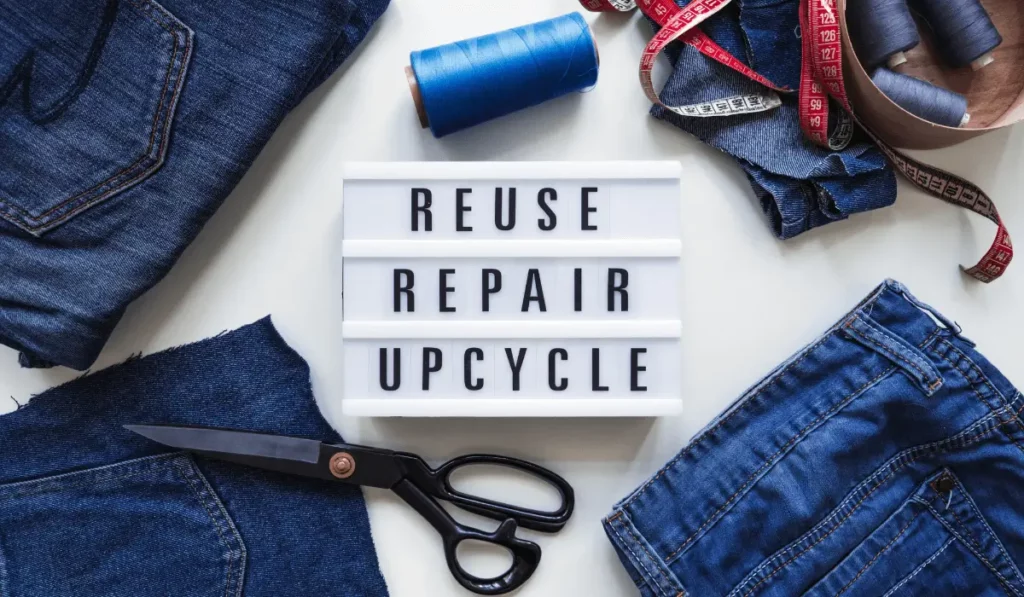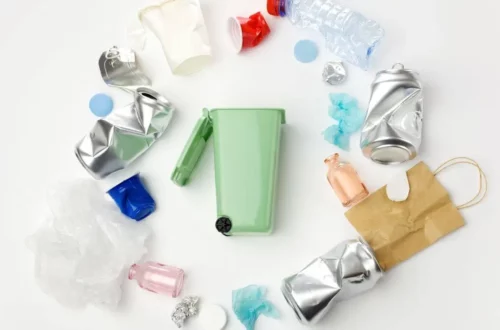The Rise of Upcycled Clothing: A Sustainable and Stylish Fashion Choice

Did you know that the fashion industry generates tons of textile waste each year? With the current linear-fashion process, clothing often ends up in landfills, contributing to environmental pollution. But there’s a rising trend that’s not only stylish but also sustainable: upcycled clothing.
Imagine turning a collection of unwanted clothing into a fresh new piece with a funky new look. Upcycling involves creative processes like combining materials, repurposing surplus garments, and using recycled fabrics. It’s an innovative way to reduce waste, conserve resources, and give new life to old items.
In this article, we’ll dive into the world of upcycled clothing and explore its environmental and social benefits. We’ll showcase examples of unconventional material choices and highlight the uprising of zero waste fashion brands. You’ll discover how upcycled fashion is making a positive impact on the fashion industry and why it’s becoming a popular choice for those seeking sustainable alternatives.
Read on as we explore the intersection of style and sustainability and learn how upcycled clothing can be an excellent choice for a greener, more conscious wardrobe.
Introduction to Upcycled Clothing & Fashion
Upcycled clothing is a rising trend in the fashion industry, offering a sustainable and stylish alternative to traditional fashion practices. By taking unwanted garments or materials and transforming them into new, fashionable pieces, upcycling reduces waste and promotes creativity.
This innovative approach to fashion not only addresses the issue of textile waste but also provides a solution to the environmental problems caused by the current linear-fashion process. Rather than discarding clothing into landfills, upcycled fashion gives new life to old or unused items, extending their lifespan and minimizing the need for new production.
The concept of upcycled clothing embraces the principles of sustainability and circular economy. It encourages resourcefulness, as designers find inventive ways to combine materials and create unique pieces. By upcycling surplus garments or incorporating unconventional material choices such as recycled fabric, upcycled fashion showcases the potential for creativity while reducing the industry’s reliance on virgin materials.
Upcycled clothing is not only environmentally friendly but also supports small businesses and local artisans. Many upcycled brands and designers operate on a smaller scale, offering bespoke fashion and affordable wardrobe options. By choosing upcycled clothing, consumers contribute to the growth of these businesses and can revel in the delight of owning a one-of-a-kind fashion piece.
In the next sections, we will dive deeper into the meaning of upcycled clothing, its environmental benefits, and how it supports small businesses. We will also explore the world of upcycling, providing guidance on how to upcycle clothes and showcasing notable upcycled clothing brands and fashion designers.
What Does Upcycled Clothing Mean?
Upcycled clothing refers to the process of transforming unwanted or discarded clothing items into new pieces with a higher value. Unlike recycling, which breaks down materials to create new products, upcycling involves repurposing and reshaping existing garments to create something entirely new. It is important to differentiate upcycling from downcycling as well. Downcycling is the process of converting materials into lower-value products.
Upcycled clothing allows for the preservation of the original garment’s materials, keeping the essence intact, while giving it a fresh and unique look. It encourages creativity and resourcefulness, as designers use unconventional materials and combine different fabrics to craft one-of-a-kind pieces. By embracing upcycled fashion, we can reduce the amount of textile waste that ends up in landfills, contributing to a more sustainable future for the fashion industry.
So next time you come across that old t-shirt or unwanted textile, consider giving it a new lease on life through upcycling. You’ll not only contribute to reducing waste but also add a touch of creativity and individuality to your wardrobe.
Upcycled Clothing and the Environment
Upcycled fashion plays a crucial role in promoting sustainability by offering environmental benefits and addressing the issue of textile waste. By incorporating upcycled clothing into our wardrobes, we can actively participate in reducing the industry’s reliance on virgin materials and minimizing the negative impact of textile waste on the environment.
Reduced Reliance on Virgin Materials
The conventional fashion industry heavily relies on the production of new materials such as cotton, polyester, and other synthetic fabrics. The extraction and manufacturing processes associated with these materials have significant environmental consequences, including water consumption, water pollution, and greenhouse gas emissions. Upcycled clothing, on the other hand, diverts existing garments and waste materials from landfills, reducing the need for the production of new materials. By giving new life to these items, upcycled fashion helps conserve valuable resources and minimizes the environmental footprint associated with the manufacturing of virgin materials.
Dealing with Textile Waste
The fashion industry generates a staggering amount of textile waste each year, contributing to the global waste crisis. Upcycling serves as an innovative solution to this problem by repurposing unwanted clothing and transforming it into fresh, new pieces. Through creative processes such as patchwork, fabric manipulation, and sourcing materials from unconventional sources, upcycled fashion gives discarded garments a second chance. By keeping these items in circulation, upcycling reduces the volume of textile waste that would otherwise end up in landfills or incinerated, causing further harm to the environment.
Also read: Zero-Waste Kitchen Swaps You Need to Make
Upcycled Clothing Supports Small Businesses
In addition to its environmental benefits, upcycled clothing also plays a significant role in supporting small businesses. By choosing upcycled fashion, consumers contribute to the growth and sustainability of bespoke fashion and affordable wardrobe options. Here’s how upcycled clothing supports small businesses:
1. Bespoke Fashion
Upcycled clothing allows small businesses to showcase their creativity and craftsmanship by transforming pre-loved garments into unique, one-of-a-kind pieces. These bespoke creations offer a personalized touch, reflecting the individual style and preferences of both the designer and the wearer. Supporting upcycled fashion means supporting these small businesses and their commitment to sustainable, handcrafted clothing.
2. Affordable Wardrobe Options
One of the advantages of upcycled clothing is its affordability. Small businesses that specialize in upcycling often source materials from thrift stores, charity shops, or even donations. These cost-effective materials allow them to offer their customers more budget-friendly options without compromising on style or quality. By purchasing upcycled clothing, consumers can build a sustainable and fashionable wardrobe without breaking the bank.
3. Community Impact
Supporting small businesses that focus on upcycled clothing has a positive effect on local communities. These businesses often employ local artisans, seamstresses, and other skilled individuals, creating job opportunities and stimulating the local economy. By choosing upcycled fashion, consumers contribute to the growth and success of these small businesses, fostering a sense of community and supporting local talent.
4. Promoting Ethical Practices
Buying upcycled clothing aligns with ethical consumption practices, as it helps reduce the demand for fast fashion and mass production. By supporting small businesses that prioritize sustainability and ethical practices, consumers actively contribute to changing the fashion industry’s detrimental impact on the environment and human rights.
Also read: How Sustainable Waste Management Can Benefit Your Business and the Environment
How to Upcycle Clothes
If you’re looking to reduce waste and unleash your creativity, upcycling clothes is a fantastic option. Transforming old or unused garments into something new and unique not only contributes to a more sustainable fashion industry but also allows you to showcase your personal style. Here are some DIY tips to help you get started on your upcycling journey:
1. Assess Your Wardrobe
Begin by taking inventory of your clothes and identifying items that no longer fit or suit your style. These pieces will serve as the foundation for your upcycling projects. Look for garments with interesting patterns, durable fabrics, or unique design elements that can be repurposed.
2. Get Creative with Techniques
Explore various upcycling techniques to breathe new life into your clothing. You can try techniques like patchwork, embroidery, fabric dyeing, or even appliqué. Experiment with different textures and colors to create stunning one-of-a-kind designs.
3. Embellish and Modify
Consider embellishing your clothes with buttons, beads, or ribbons to add extra flair. You can also modify the silhouette by altering hemlines, shortening or lengthening sleeves, or transforming a dress into a top. Don’t shy away from experimenting and embracing your inner designer.
4. Seek Online Repair Services
If you’re not confident in your upcycling skills, don’t worry. Many online repair services specialize in fixing and transforming garments. They can mend holes, replace buttons, or even add tailored alterations to your clothes, giving them new life and preventing them from ending up in landfills.
5. Support Upcycling Businesses and Brands
If you don’t have the time or inclination to upcycle yourself, support businesses and brands that focus on upcycling. Look for local upcycling businesses or browse online platforms that feature upcycled fashion. By purchasing from these brands, you’ll be promoting sustainability and contributing to a circular economy.
Remember, upcycling clothes is not only an eco-friendly choice but also a reflection of your individual style and creativity. With a little imagination and some basic sewing skills, you can transform unwanted garments into fresh, fashionable pieces that make a positive impact on the environment. So grab your scissors, thread, and needle, and let your upcycling journey begin!
Also read: How to Achieve a Zero-Waste Bathroom
Upcycling Brands and Fashion Designers
In the world of fashion, upcycling has given rise to a wave of innovative brands and designers who are transforming discarded materials into stylish treasures. These notable upcycling brands and fashion designers are leading the way in sustainable fashion, demonstrating that style and environmental consciousness can go hand in hand.
1. Reformation – Known for its chic and feminine designs, Reformation incorporates upcycled fabrics alongside sustainable materials, championing a circular fashion system. Their commitment to transparency and ethical practices has garnered a loyal following.
2. Stella McCartney – As a pioneer in sustainable fashion, Stella McCartney has been at the forefront of upcycling. McCartney’s collections embrace unconventional material choices, using surplus garments and recycled fabrics to create timeless pieces that reduce waste.
3. Patagonia – While primarily recognized as an outdoor apparel brand, Patagonia has also delved into upcycling. They repurpose old garments and transform them into new items, reducing the demand for virgin materials and diverting waste from landfills.
4. Eileen Fisher – With a focus on simplicity and timeless style, Eileen Fisher is committed to circularity. Their Renew program takes back used garments to create fresh new pieces, providing customers with a sustainable and stylish alternative.
5. Christopher Raeburn – This British designer is celebrated for his innovative approach to upcycled fashion. Raeburn incorporates surplus military fabrics and materials, transforming them into fashion-forward garments that challenge traditional concepts of waste.
These pioneers demonstrate that upcycled fashion is not only eco-friendly but also an excellent place to find unique and one-of-a-kind pieces. By supporting upcycling brands and fashion designers, we can contribute to reducing the fashion industry’s environmental impact and promote a more sustainable future.
Also read: The Importance of Implementing the 5Rs of Waste Management
Final Thoughts on the Power of Upcycled Clothing
Upcycled clothing is not just a trendy fashion choice, but also a sustainable solution to the environmental and social issues plaguing the fashion industry. By repurposing unwanted garments and materials, upcycled fashion reduces the reliance on virgin resources and diverts tons of textile waste from landfills. It also supports small businesses, allowing for personalized and affordable wardrobe options while fostering creativity and innovation.
Engaging in DIY upcycling projects or supporting upcycled clothing brands and designers empowers individuals to make a positive impact on the planet. By choosing upcycled fashion, we can reduce water consumption, greenhouse gas emissions, and the overall ecological footprint of the fashion industry. Furthermore, embracing upcycled clothing promotes a shift away from the fast fashion model that perpetuates unsustainable practices and human rights issues.
Let’s remember that by opting for upcycled clothing, we can make a fashion statement without compromising the environment or our values.





